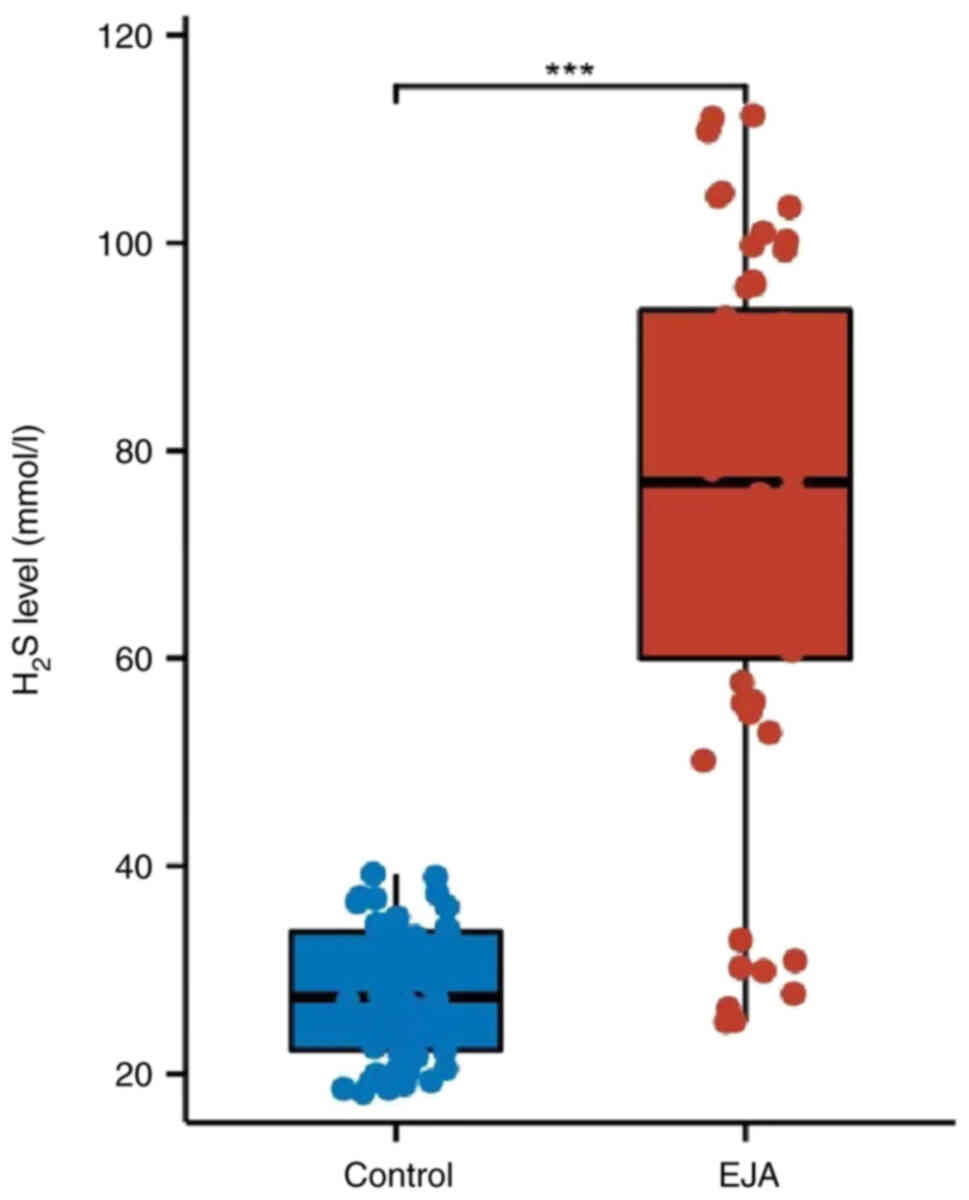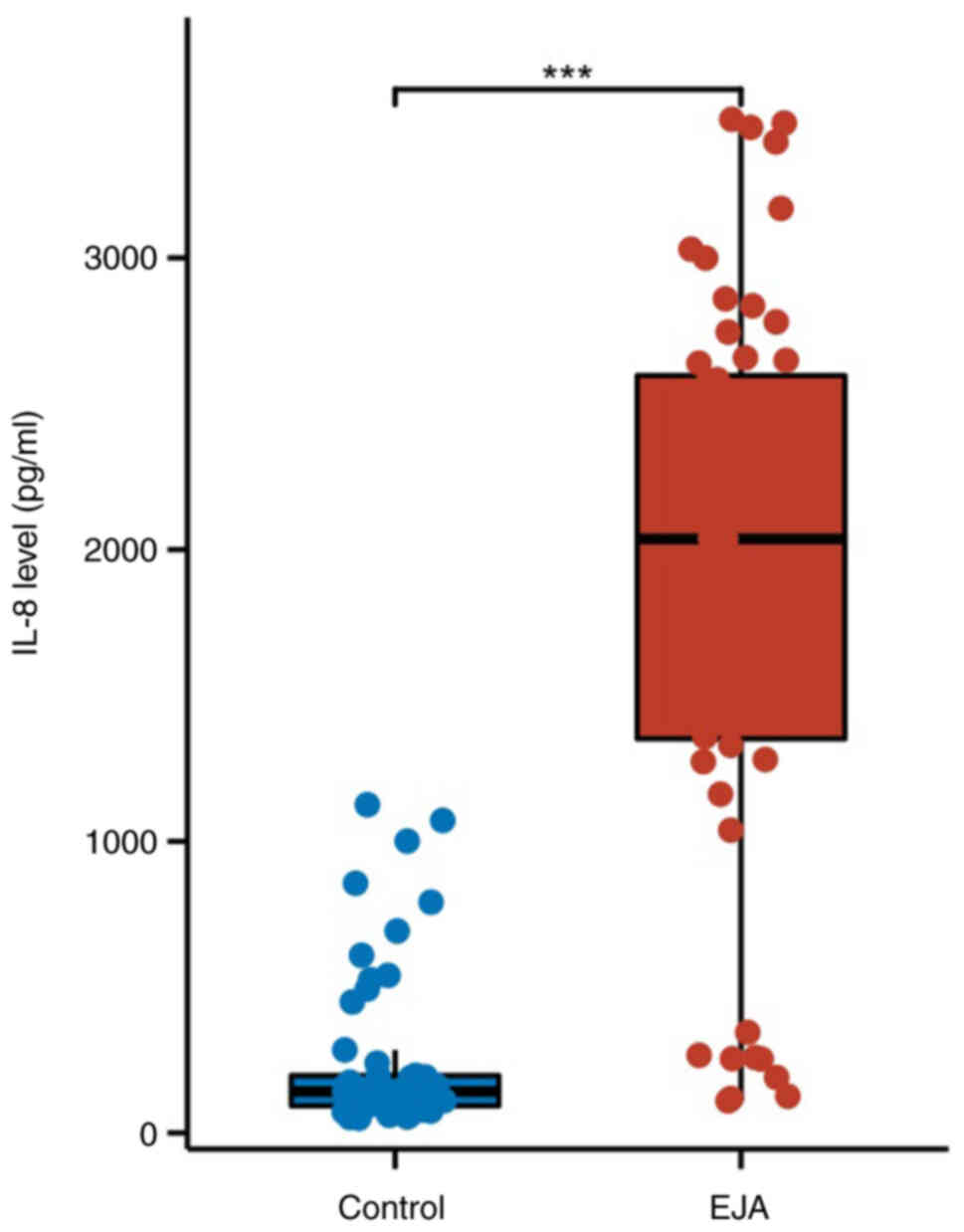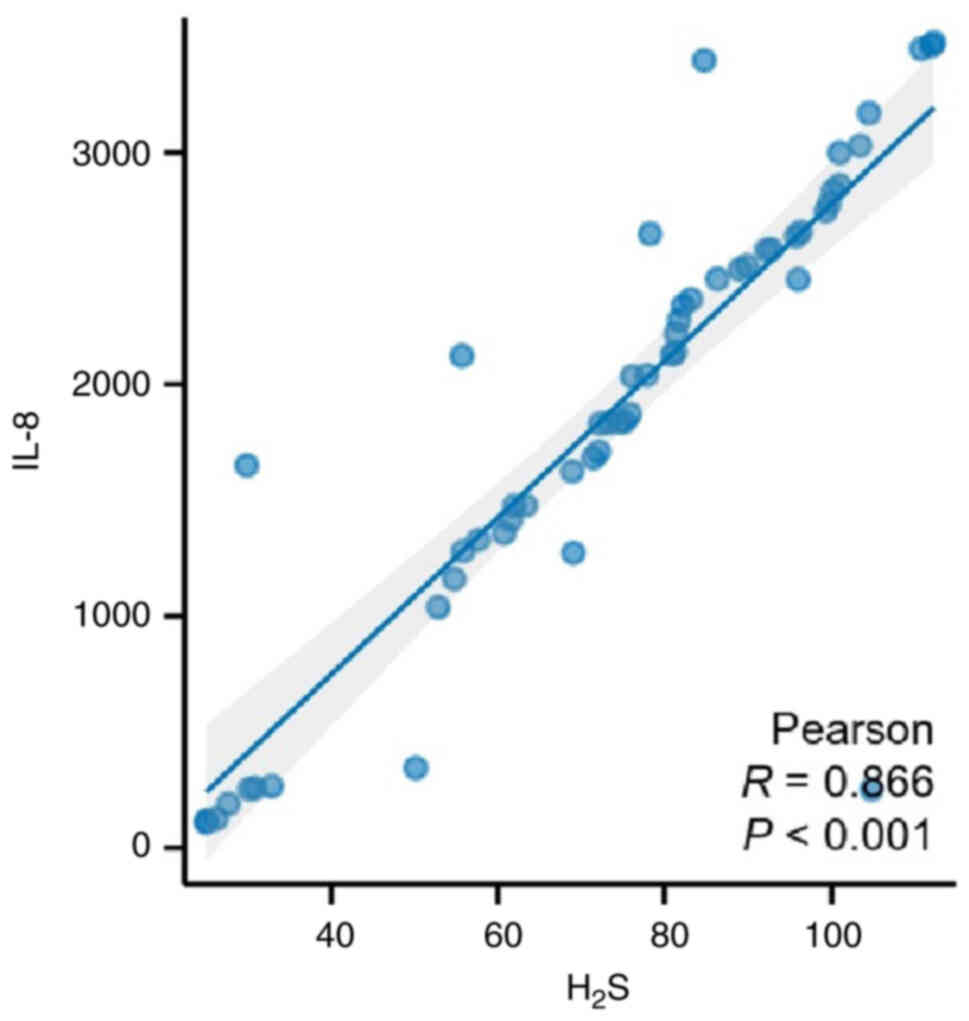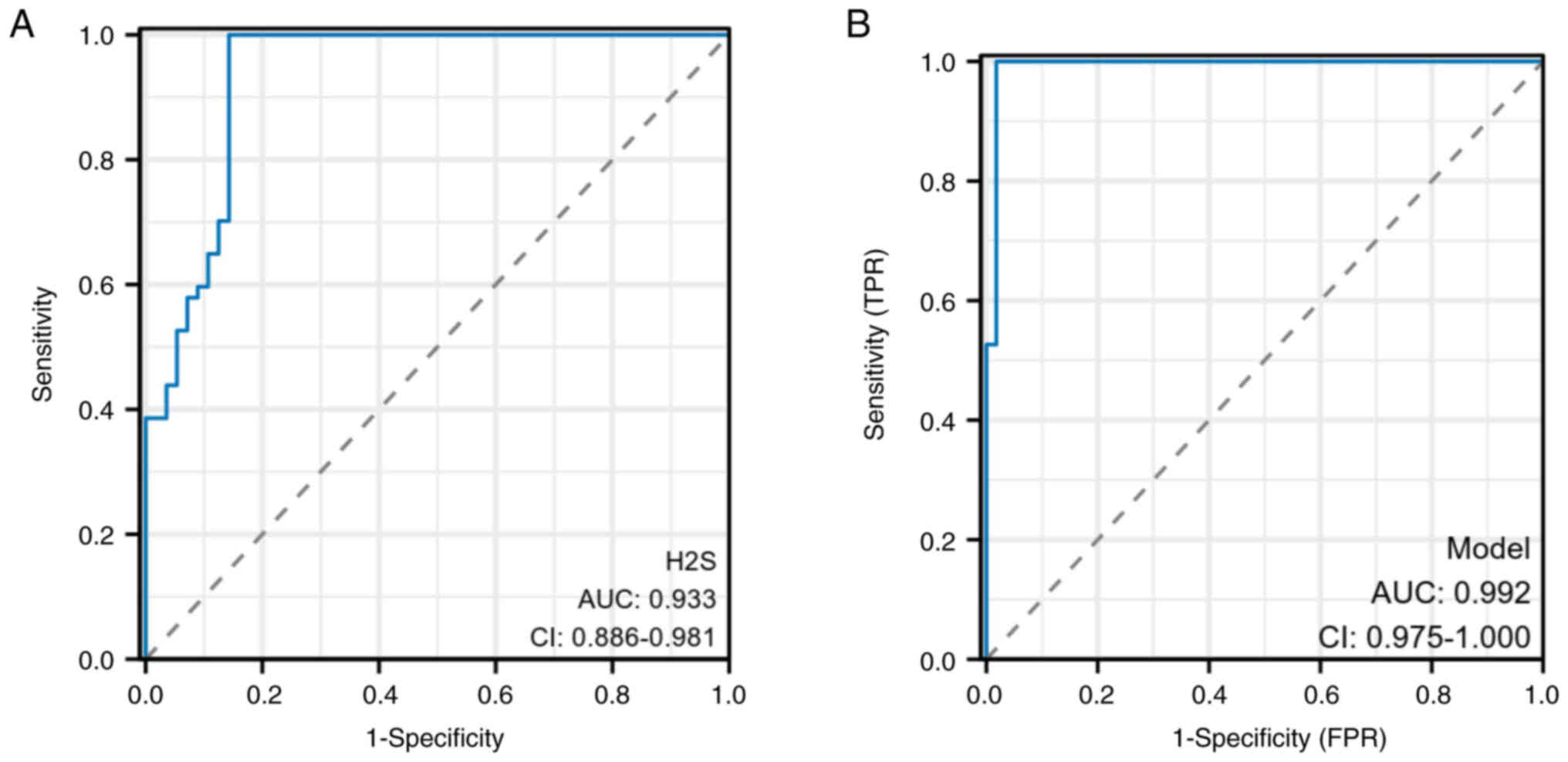Value of exhaled hydrogen sulfide in early diagnosis of esophagogastric junction adenocarcinoma
- Authors:
- Published online on: May 14, 2024 https://doi.org/10.3892/ol.2024.14454
- Article Number: 321
-
Copyright: © Liu et al. This is an open access article distributed under the terms of Creative Commons Attribution License.
Abstract
Introduction
Esophagogastric junction adenocarcinoma (EJA) is a prevalent malignant tumor of the digestive tract (1). The biological behavior of EJA differs from that of its adjacent esophageal and gastric cancers, with a worse prognosis compared with that of the other two (2,3). The incidence of EJA has been alarmingly increasing worldwide in recent years. However, due to its unique biological characteristics, controversies surrounding the pathogenesis, pathology, clinical treatment and prognosis of EJA remain. Most patients with EJA are diagnosed at an advanced stage due to the lack of specific clinical symptoms and effective early diagnostic methods. By this time, the tumor may have already widely invaded and metastasized, particularly in China where gastrointestinal malignancies are highly prevalent. Consequently, most patients with EJA are diagnosed at intermediate or late stages of tumor progression with a 5-year survival rate <30% (4). Therefore, identifying convenient and effective methods to improve the rates of early diagnosis for EJA is crucial for enhancing prognosis and survival rates.
Hydrogen sulfide (H2S) is the third endogenous gaseous signaling molecule, following carbon monoxide (5). Numerous studies have demonstrated the diverse range of biological activities of H2S in glucose metabolism, ischemia-reperfusion injury, stress and endotoxemia (6–9). H2S actively participates in various physiological and pathological processes within multiple systems. It exists in vivo as H2S gas or sodium hydrosulfide (NaHS). The dissociated H2S ions from NaHS combine with hydrogen ions to generate H2S, maintaining homeostasis within the body. Mammals possess more than one pathway for producing H2S using L-cysteine (L-Cys substrate). The primary pathways involve cystathionine-β-synthase (CBS) and cystathionine-γ-lyase (CSE). A high concentration of NaHS can reduce cellular oxidative stress levels, subsequently activating the mitogen active protein kinase pathway while upregulating gene expression. This induction prompts intestinal epithelial cells to malignant transformation (10).
Interleukin-8 (IL-8) is a member of the chemokine family that attracts neutrophil infiltration by acting on the C-X-C chemokine receptor type 1 (11). The immunosuppressive effect of the tumor microenvironment is promoted by chemotaxis of neutrophils and myeloid suppressor cells (12). Tumor cells secrete a significant amount of IL-8 to facilitate the progression and metastasis of tumor cells (13). Known as Barrett's esophagus, metaplasia of the single columnar epithelium is a precancerous lesion in the development of EJA (14). The upregulation of IL-8 expression in Barrett's esophagus tissue inflammation is related to intraepithelial neutrophil granulocytes, which may be affected by the epithelial secretion of IL-8 (15). In addition, both IL-8 mRNA and protein levels are upregulated in EJA (16). IL-8 can thus be used as an early diagnostic marker for EJA (17).
Increased H2S concentrations have been reported in colon cancer tissues compared with those in adjacent normal tissues (18). Colorectal cancer (CRC) cells are able to synthesize more H2S and release it into the tumor microenvironment (19). Reportedly, H2S expression increases in multidrug-resistant CRC cells (20). Moreover, H2S-producing Clostridium and Bacillus fragilis are significantly enriched in early-stage CRC, and H2S produced by Clostridium nucleate and other microorganisms may promote tumor development by destroying host cells and DNA (21). In recent years, different diagnostic probes and combination therapy approaches, as well as tumor treatment pathways mediated by H2S have been developed (22). It has been observed that H2S is expressed in the tumor tissues of colorectal adenoma and bladder cancer making it a potential diagnostic marker (23,24). However, the expression level of H2S in EJA and its diagnostic value remain unexplored. Gastrointestinal gas analysis holds promise as a diagnostic technique. Therefore, the present study aimed to assess and compare exhaled H2S in patients with EJA with that in healthy controls. Additionally, correlations between exhaled H2S and clinical diagnosis of EJA were analyzed to determine the clinical significance of this biomarker.
Patients and methods
Research participants
A total of 56 patients (36 males and 20 females; mean age, 56.61±10.65 years) with EJA, who underwent surgical treatment at Hebei Medical University Fourth Affiliated Hospital (Shijiazhuang, China) from January 2019 to December 2021, were included in the EJA group. All patients underwent gastroscopy and received a pathological diagnosis confirming EJA without any previous history of tumors. These patients were treated for the first time without prior radiotherapy or chemotherapy. Early-stage EJA was defined as AJCC Staging Manual 8th edition stages I and II (1). Exclusion criteria consisted of: i) Patients with other malignancies or severe cardiovascular, pulmonary, or renal diseases where diagnosis was unclear; ii) patients with a history of gastrointestinal surgery or trauma that altered anatomy and function; iii) patients who had bowel surgery or were preparing for bowel surgery, and those who were pregnant and lactating; and iv) patients on antibiotics, lactulose, acid suppressants, or drugs affecting gastrointestinal motility within the past 4 weeks. Additionally, a healthy control group consisting of 57 individuals (38 males and 19 females; mean age, 58.54±10.35 years), without any autoimmune diseases, tumors or organic lesions (Table I) was also formed. The present study adhered to the ethical standards set by the responsible committee on human experimentation, namely, the Ethics Committee of Hebei Medical University Fourth Affiliated Hospital, Shijiazhuang, China; approval no. 2018MEC108), following the principles outlined in The Declaration of Helsinki. All the patients and their families were informed about the study details and provided written informed consent.
Exhaled H2S determination
Based on a previously published study (23), exhaled H2S tests were performed using Nanocoulomb breath analyzer DA6000 (Sunvou Medical Electronics Co., Ltd.). Briefly, all participants had to fast for 12 h before the test, and avoid exercise and smoking on the day of the test. Participants wrapped their lips tightly with a disposable filter. After inhaling through the filter, they held their breath for 15 sec and then forcefully exhaled. Animation software (Breathing Zone 13.0; Breathing Zone Limited) was used to coordinate the exhalation rhythm. The analyzer automatically collected the end-expiratory air. After the acquisition process was complete, the analyzer automatically analyzed the exhaled gas and displayed the results immediately. To eliminate the effects of H2S in the environment, the participants first inhaled through the H2S filter and then exhaled at a set flow rate, expiratory pressure and exhalation time. Calibration with 50 parts per billion (PPB) and 200 PPB H2S/N2 standard gas, supplied by the manufacturer prior to daily testing, was performed to ensure the accuracy of the test.
Enzyme-linked immunosorbent assay (ELISA)
Patient serum was collected within 24 h of admission before treatment and immediately stored at −80°C until use. Serum IL-8 concentrations were measured using a commercial ELISA kit (cat. no. H008-1-2; Nanjing Jiancheng Bioengineering Institute), according to the manufacturer's instructions. All trained operators were blinded to the characteristics of the patients with EJA and healthy controls. Briefly, the preparation of blank wells, standard holes and sample holes was performed. After washing, 100 µl of enzymatic secondary antibody was added, incubated at 37°C for 60 min, washed repeatedly, and then color was added to the developing solution, followed by incubation at room temperature for 20 min and the addition of termination solution. The absorbance at 450 nm per hole was measured using the developing method. The average OD values were calculated after the difference in the duplicate wells was <10%.
Statistical analysis
The experimental data are expressed as the mean ± standard deviation. SPSS 21.0 (IBM Corp.) and GraphPad Prism 8.0 (GraphPad Software; Dotmatics) were used for data analysis. Unpaired Student's t-test was used for comparison between the two groups. Pearson correlation coefficient was used to analyze the correlation between H2S and IL-8. The diagnostic value of H2S or its combination with IL-8 was evaluated using receiver operating characteristic (ROC) curves, according to the area under the curve (AUC) with 95% confidence interval (CI). P<0.05 was considered to indicate a statistically significant difference. All experiments were performed three times.
Results
Exhaled H2S is increased in patients with EJA
The exhaled indicator results showed significantly higher levels of H2S exhaled in patients with EJA compared with those in healthy controls (Fig. 1; P<0.05).
Expression levels of IL-8 in patients with EJA
The expression levels of IL-8 were determined using ELISA. The results revealed that the levels of IL-8 in patients with EJA were significantly higher than those in the control group (Fig. 2; P<0.05).
Exhaled H2S is positively correlated with IL-8 expression in patients with EJA
Pearson's correlation coefficient was used to analyze the correlation between H2S exhaled and serum IL-8 in patients with EJA. The results showed that exhaled H2S was positively correlated with IL-8 expression (Fig. 3; P<0.001).
Evaluation of the clinical value of miR-29c and miR-146a in diagnosing EJA
To evaluate the diagnostic value of exhaled H2S, ROC curves were generated based on the two groups. The results revealed that exhaled H2S had high diagnostic accuracy, with an AUC of 0.933 (sensitivity, 92.9%; and specificity, 85.7%) (Fig. 4A). Moreover, exhaled H2S combined with serum IL-8 exhibited greater diagnostic value with an AUC of 0.992 (sensitivity, 99.1%; and specificity, 98.2%) (Fig. 4B), indicating that this combination led to a significant improvement in diagnostic ability.
Discussion
In the present study, a small quantity of H2S was detected in patients with EJA, indicating endogenous origin as there was no H2S detected in the inhaled and swallowed air of the healthy individuals. There are two pathways for H2S synthesis in the intestinal tissue: i) Enzymatic and ii) non-enzymatic. The primary enzymatic pathway involves endogenous H2S production by CBS and CSE enzymes and involves fermentation of sulfur-containing amino acids and sulfates by H2S. Increased production of H2S is a characteristic pathophysiological feature of colorectal adenoma (25). Overall there is an upward trend in the production of H2S among patients with EJA. Additionally, it has been reported that human colon cancer cell lines (HCT-116 and SW-480) produce H2S (26). In the present study, exhaled H2S levels were examined in patients with EJA for the first time, revealing higher levels compared with those in healthy individuals. This may be attributed to an increase in endogenous H2S synthesis within tumor cells, accompanied by alterations in gut microbiota metabolism, thus favoring enhanced production of H2S.
The endogenous H2S molecule is small and has a solubility in fat-soluble solvents that is five times higher than that in water, enabling it to freely traverse cell membranes (5). H2S exists in the body in two forms, 1/3 is in the form of gas H2S and 2/3 are in the form of NaHS. NaHS is not only the donor of H2S, but also its precursor and a dynamic balance is formed between these two forms (27). Within mitochondria, glutathione catalyzes the oxidation of most H2S into sulfate and thiosulfate. In the cytoplasm, small amounts of H2S are converted into less toxic methylmercaptan and dimethylsulfate through methylation, with these metabolites being excreted by the kidneys, intestines and lungs. Consequently, under normal physiological conditions, there is minimal accumulation of H2S (28). Reportedly, H2S promotes tumor proliferation, metastasis, differentiation and neovascularization while providing nutrition for tumor cell growth and facilitating tumor progression (29,30). Furthermore, in certain gastrointestinal cancers such as CRC, where increased levels of H2S occurs due to enzymatic synthesis within colon cells or release from intestinal microorganisms followed by oxidation within colon cell mitochondria (31), upregulation of endogenous synthase may be responsible for elevated levels of H2S in cancer cells. The high concentration of colonic cavity-derived H2S has been suggested to contribute to CRC pathogenesis (32). However, limited research exists on the association between H2S and EJA. The present study discovered that exhaled H2S was significantly elevated in patients with EJA, suggesting potential involvement in EJA development. This needs to be further analyzed and confirmed in future experiments. In addition, the ROC curve in the present study showed that the AUC, sensitivity and specificity of H2S diagnosis of EJA were 0.933, 92.9 and 85.7%, respectively, indicating that H2S has diagnostic potential for EJA. Serum levels of IL-8 revealed significant results in the diagnosis of early-stage EJA (17). In the present study, exhaled H2S combined with patient serum IL-8 was also used to diagnose early-stage EJA. The results demonstrated that combined detection was superior to single detection, and it significantly improved sensitivity, specificity and AUC.
The present study has some limitations. First, the patients enrolled in this study were all diagnosed with EJA and whether exhaling H2S could be used for diagnosis in asymptomatic individuals needs to be analyzed in future studies. Second, the present study did not analyze whether there were differences in H2S between patients with stage I and II EJA. Therefore, whether H2S levels change with different stages of the disease will be the topic of future research. In addition, the sample size of this study was limited and may not be representative of all patients with EJA. The high AUC values in this study may have potential overfitting. The sample size needs to be expanded to further clarify the diagnostic value of exhaled H2S in an EJA population. Therefore, the authors of the present study anticipate to further expand the sample size in future experiments. Moreover, further in vitro experiments are required to confirm the underlying mechanism between H2S and EJA. Therefore, expanding the sample size in future studies may further comprehensively identify the role played by H2S in EJA through additional experiments.
In conclusion, the results indicated that increased levels of exhaled H2S in patients with EJA may indicate its involvement in the occurrence and development of EJA. Exhaled H2S holds promise as an early diagnostic indicator for EJA. Furthermore, combining H2S and IL-8 detection serum can enhance diagnostic efficacy. These results provided broader prospect for the early diagnosis of EJA.
Acknowledgements
Not applicable.
Funding
Funding: No funding was received.
Availability of data and materials
The data generated in the present study may be requested from the corresponding author.
Authors' contributions
FL and GL made substantial contributions to the conception, design and draft of the manuscript. QL contributed in the acquisition, analysis and interpretation of the data. LW and BZ made substantial contributions to the conception of the study and its critical revision for important intellectual content. XS and JJ made substantial contributions to the conception, design and supervision of the study, and reviewed and edited the manuscript. FL and GL confirm the authenticity of all the raw data. All authors read and approved the final version of the manuscript. All authors have participated sufficiently in the work to take public responsibility for appropriate portions of the content and agreed to be accountable for all aspects of the work in ensuring that questions related to its accuracy.
Ethics approval and consent to participate
The study adhered to ethical standards set by the responsible committee on human experimentation, namely the Ethics Committee of Hebei Medical University Fourth Affiliated Hospital, Shijiazhuang, China; approval no. 2018MEC108), following the principles outlined in The Declaration of Helsinki. All patients provided written informed consent.
Patient consent for publication
Not applicable.
Competing interests
The authors declare that they have no competing interests.
References
|
Hasegawa S and Yoshikawa T: Adenocarcinoma of the esophagogastric junction: Incidence, characteristics, and treatment strategies. Gastric Cancer. 13:63–73. 2010. View Article : Google Scholar : PubMed/NCBI | |
|
McManus DT, Olaru A and Meltzer SJ: Biomarkers of esophageal adenocarcinoma and Barrett's esophagus. Cancer Res. 64:1561–1569. 2004. View Article : Google Scholar : PubMed/NCBI | |
|
Zhou Y, Zhang Z, Zhang Z, Wu J, Ren D, Yan X, Wang Q, Wang Y, Wang H, Zhang J, et al: A rising trend of gastric cardia cancer in Gansu Province of China. Cancer Lett. 269:18–25. 2008. View Article : Google Scholar : PubMed/NCBI | |
|
Zhao JJ and Liu FL: Laparoscopic proximal gastrectomy and lymph node resection in adenocarcinoma of the esophagogastric junction. Zhonghua Wei Chang Wai Ke Za Zhi. 25:114–119. 2022.(In Chinese). PubMed/NCBI | |
|
Guo FF, Yu TC, Hong J and Fang JY: Emerging roles of hydrogen sulfide in inflammatory and neoplastic colonic diseases. Front Physiol. 7:1562016. View Article : Google Scholar : PubMed/NCBI | |
|
Landry AP, Ballou DP and Banerjee R: Hydrogen sulfide oxidation by sulfide quinone oxidoreductase. Chembiochem. 22:949–960. 2021. View Article : Google Scholar : PubMed/NCBI | |
|
Wilkie SE, Borland G, Carter RN, Morton NM and Selman C: Hydrogen sulfide in ageing, longevity and disease. Biochem J. 478:3485–3504. 2021. View Article : Google Scholar : PubMed/NCBI | |
|
Dilek N, Papapetropoulos A, Toliver-Kinsky T and Szabo C: Hydrogen sulfide: An endogenous regulator of the immune system. Pharmacol Res. 161:1051192020. View Article : Google Scholar : PubMed/NCBI | |
|
Zhang YX, Jing MR, Cai CB, Zhu SG, Zhang CJ, Wang QM, Zhai YK, Ji XY and Wu DD: Role of hydrogen sulphide in physiological and pathological angiogenesis. Cell Prolif. 56:e133742023. View Article : Google Scholar : PubMed/NCBI | |
|
Ye M, Yu M, Yang D, Li J, Wang H, Chen F, Yu H, Shen T, Zhu Q and Zhou C: Exogenous hydrogen sulfide donor NaHS alleviates nickel-induced epithelial-mesenchymal transition and the migration of A549 cells by regulating TGF-β1/Smad2/Smad3 signaling. Ecotoxicol Environ Saf. 195:1104642020. View Article : Google Scholar : PubMed/NCBI | |
|
Alfaro C, Sanmamed MF, Rodríguez-Ruiz ME, Teijeira Á, Oñate C, González Á, Ponz M, Schalper KA, Pérez-Gracia JL and Melero I: Interleukin-8 in cancer pathogenesis, treatment and follow-up. Cancer Treat Rev. 60:24–31. 2017. View Article : Google Scholar : PubMed/NCBI | |
|
Matsushima K, Yang D and Oppenheim JJ: Interleukin-8: An evolving chemokine. Cytokine. 153:1558282022. View Article : Google Scholar : PubMed/NCBI | |
|
Fousek K, Horn LA and Palena C: Interleukin-8: A chemokine at the intersection of cancer plasticity, angiogenesis, and immune suppression. Pharmacol Ther. 219:1076922021. View Article : Google Scholar : PubMed/NCBI | |
|
McQuaid KR, Laine L, Fennerty MB, Souza R and Spechler SJ: Systematic review: The role of bile acids in the pathogenesis of gastro-oesophageal reflux disease and related neoplasia. Aliment Pharmacol Ther. 34:146–165. 2011. View Article : Google Scholar : PubMed/NCBI | |
|
Isomoto H, Saenko VA, Kanazawa Y, Nishi Y, Ohtsuru A, Inoue K, Akazawa Y, Takeshima F, Omagari K, Miyazaki M, et al: Enhanced expression of interleukin-8 and activation of nuclear factor kappa-B in endoscopy-negative gastroesophageal reflux disease. Am J Gastroenterol. 99:589–597. 2004. View Article : Google Scholar : PubMed/NCBI | |
|
Jenkins GJS, Mikhail J, Alhamdani A, Brown TH, Caplin S, Manson JM, Bowden R, Toffazal N, Griffiths AP, Parry JM and Baxter JN: Immunohistochemical study of nuclear factor-kappaB activity and interleukin-8 abundance in oesophageal adenocarcinoma; a useful strategy for monitoring these biomarkers. J Clin Pathol. 60:1232–1237. 2017. View Article : Google Scholar : PubMed/NCBI | |
|
Li Z, Xu H, Yu J, Liu C, Zheng C, Zeng R, Xu L, Li E, Peng Y and Xu Y: The early diagnostic value of serum interleukin-8 in esophagogastric junction adenocarcinoma. Cancer Control. 28:107327482110048832021. View Article : Google Scholar : PubMed/NCBI | |
|
Fang Y, Yan C, Zhao Q, Xu J, Liu Z, Gao J, Zhu H, Dai Z, Wang D and Tang D: The roles of microbial products in the development of colorectal cancer: A review. Bioengineered. 12:720–735. 2021. View Article : Google Scholar : PubMed/NCBI | |
|
Yue T, Li J, Zhu J, Zuo S, Wang X, Liu Y, Liu J, Liu X, Wang P and Chen S: Hydrogen sulfide creates a favorable immune microenvironment for colon cancer. Cancer Res. 83:595–612. 2023. View Article : Google Scholar : PubMed/NCBI | |
|
Ascenção K, Lheimeur B and Szabo C: Regulation of CyR61 expression and release by 3-mercaptopyruvate sulfurtransferase in colon cancer cells. Redox Biol. 56:1024662022. View Article : Google Scholar : PubMed/NCBI | |
|
Hale VL, Jeraldo P, Mundy M, Yao J, Keeney G, Scott N, Cheek EH, Davidson J, Greene M, Martinez C, et al: Synthesis of multi-omic data and community metabolic models reveals insights into the role of hydrogen sulfide in colon cancer. Methods. 149:59–68. 2018. View Article : Google Scholar : PubMed/NCBI | |
|
Li Y, Zhou J, Wang L and Xie Z: Endogenous hydrogen sulfide-triggered MOF-based nanoenzyme for synergic cancer therapy. ACS Appl Mater Interfaces. 12:30213–30220. 2020. View Article : Google Scholar : PubMed/NCBI | |
|
Liu N, Tseng Y, Zhang H and Chen J: The role of exhaled hydrogen sulfide in the diagnosis of colorectal adenoma. Can J Infect Dis Med Microbiol. 2021:80463682021. View Article : Google Scholar : PubMed/NCBI | |
|
Gai JW, Qin W, Liu M, Wang HF, Zhang M, Li M, Zhou WH, Ma QT, Liu GM, Song W, et al: Expression profile of hydrogen sulfide and its synthases correlates with tumor stage and grade in urothelial cell carcinoma of bladder. Urol Oncol. 34:166.e15–e120. 2016. View Article : Google Scholar : PubMed/NCBI | |
|
Cao X, Ding L, Xie ZZ, Yang Y, Whiteman M, Moore PK and Bian JS: A review of hydrogen sulfide synthesis, metabolism, and measurement: Is modulation of hydrogen sulfide a novel therapeutic for cancer? Antioxid Redox Signal. 31:1–38. 2019. View Article : Google Scholar : PubMed/NCBI | |
|
Cai WJ, Wang MJ, Ju LH, Wang C and Zhu YC: Hydrogen sulfide induces human colon cancer cell proliferation: Role of Akt, ERK and p21. Cell Biol Int. 34:565–572. 2010. View Article : Google Scholar : PubMed/NCBI | |
|
Furne J, Springfield J, Koenig T, DeMaster E and Levitt MD: Oxidation of hydrogen sulfide and methanethiol to thiosulfate by rat tissues: A specialized function of the colonic mucosa. Biochem Pharmacol. 62:255–259. 2001. View Article : Google Scholar : PubMed/NCBI | |
|
Munteanu C, Turnea MA and Rotariu M: Hydrogen Sulfide: An emerging regulator of oxidative stress and cellular homeostasis-a comprehensive one-year review. Antioxidants (Basel). 12:17372023. View Article : Google Scholar : PubMed/NCBI | |
|
Khattak S, Rauf MA, Khan NH, Zhang QQ, Chen HJ, Muhammad P, Ansari MA, Alomary MN, Jahangir M, Zhang CY, et al: Hydrogen sulfide biology and its role in cancer. Molecules. 27:33892022. View Article : Google Scholar : PubMed/NCBI | |
|
Shackelford RE, Mohammad IZ, Meram AT, Kim D, Alotaibi F, Patel S, Ghali GE and Kevil CG: Molecular functions of hydrogen sulfide in cancer. Pathophysiology. 28:437–456. 2021. View Article : Google Scholar : PubMed/NCBI | |
|
Lin H, Yu Y, Zhu L, Lai N, Zhang L, Guo Y, Lin X, Yang D, Ren N, Zhu Z and Dong Q: Implications of hydrogen sulfide in colorectal cancer: Mechanistic insights and diagnostic and therapeutic strategies. Redox Biol. 59:1026012023. View Article : Google Scholar : PubMed/NCBI | |
|
Sakuma S, Minamino S, Takase M, Ishiyama Y, Hosokura H, Kohda T, Ikeda Y and Fujimoto Y: Hydrogen sulfide donor GYY4137 suppresses proliferation of human colorectal cancer Caco-2 cells by inducing both cell cycle arrest and cell death. Heliyon. 5:e022442019. View Article : Google Scholar : PubMed/NCBI |













